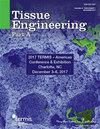Characterisation of human fetal progenitor populations and response to osteogenic growth factors: a model system for mesenchymal lineage differentiation
引用次数: 3
Abstract
We have previously demonstrated that porous poly-(epsiloncalprolactone) films with regularly spaced, controlled pore sizes provide adhesion and support for cultured dermal fibroblasts. We have determined the effects of applying various sized porous films (n¼3 for each treatment) on 4mm punch biopsy wounded mice to assess wounding response. Films with pores ranging in size from 3–20 microns, elicited a mild lymphocytic and foreign body perifollicular immune response, regardless of pore size but this treatment failed to significantly shorten wound healing time or increase the rate of wound closure. By 21 days after wounding the grafted porous films had become fully incorporated into or completely biodegraded in the wounded tissue. Finally, we assessed the proof of principle that live cultured fibroblasts can be delivered using porous films and sustained in model SCID mouse wounds. Human fibroblasts (30,000 cells) were subconfluently cultured on 5 micron porous films. These cell/film combinations were then transplanted onto wounded mice but failed to significantly affect wound healing. However, these transplanted fibroblast cells were readily detected using anti-human HLA antibodies in wounded SCID mice skin 21 days after treatment, when the wounds had completely healed. Taken together, these data demonstrate for the first time the feasibility of using porous films to deliver living human cells into skin wounds as part of our aim to use cell therapy to improve the wound healing response.人类胎儿祖细胞群体的特征和对成骨生长因子的反应:间充质谱系分化的模型系统
我们之前已经证明,多孔聚-(epsiloncalprolactone)膜具有规则间距,孔径可控,为培养的真皮成纤维细胞提供粘附和支持。我们已经确定了在4mm穿孔活检损伤小鼠上应用不同大小的多孔膜(每种处理n¼3)的效果,以评估损伤反应。孔径在3-20微米之间的薄膜,无论孔径大小如何,都会引起轻微的淋巴细胞和异物滤泡周围免疫反应,但这种处理不能显著缩短伤口愈合时间或提高伤口愈合率。伤后21天,移植的多孔膜在损伤组织中完全融入或完全生物降解。最后,我们评估了活培养成纤维细胞可以通过多孔膜传递并在模型SCID小鼠伤口中维持的原理证明。人成纤维细胞(30,000个细胞)亚流培养在5微米多孔膜上。然后将这些细胞/膜组合移植到受伤小鼠身上,但没有显著影响伤口愈合。然而,这些移植的成纤维细胞在治疗21天后,当伤口完全愈合时,很容易在受伤的SCID小鼠皮肤中使用抗人HLA抗体检测到。综上所述,这些数据首次证明了使用多孔膜将活的人类细胞输送到皮肤伤口的可行性,这是我们使用细胞疗法改善伤口愈合反应的目标的一部分。
本文章由计算机程序翻译,如有差异,请以英文原文为准。
求助全文
约1分钟内获得全文
求助全文
来源期刊

Tissue Engineering Part A
CELL & TISSUE ENGINEERING-BIOTECHNOLOGY & APPLIED MICROBIOLOGY
自引率
0.00%
发文量
0
审稿时长
3 months
 求助内容:
求助内容: 应助结果提醒方式:
应助结果提醒方式:


